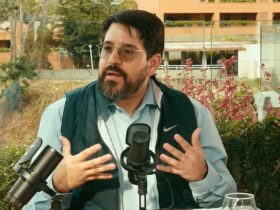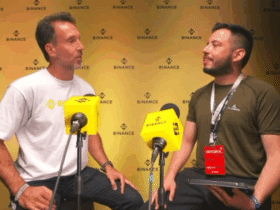Children in El Salvador learn to use mini ASIC, Coldcard and Sparrow.
Bitcoin is a suitable medium to teach children the savings paradigm.
NodeNationSV is an educational platform that operates in El Salvador and brings Bitcoin teaching to the country’s schools. At the time of writing, NodeNation has “graduated” 1 Salvadoran school in Bitcoin in 2023 and 5 in 2024.
According to the leader of NodeNation El Salvador, who calls himself “PupusasG” and was interviewed by CriptoNoticias, the platform plans to reach about 25 Salvadoran schools this year.
In his interview, the project leader assured that NodeNation’s educational horizon is even larger, and intends to expand in the next 5 years. “Throughout the Salvadoran territory we have 6,000 schools that will be part of the project in a maximum period of 5 years,” he comments.

When asked if teaching children in El Salvador is an indirect way of teaching parents about Bitcoin, PupusasG answered yes.
Indeed they do, not only to their parents but to their friends in their neighborhoods and family who do not live with them, teaching children in a fun way motivates them to talk about their day at school with everyone they know.
PupusasG, leader of NodeNation El Salvador.
NodeNation prioritizes educational games and fun
How does NodeNation teach? Putting play as a central method, using analogies, technological games and physical activities that “teach the properties of solid money such as divisibility, fungibility, among others.”
This form of teaching would help make Bitcoin more understandable, a technology that is not easy for adults to grasp right away and that presents challenges in the teaching process.
“The most effective way to teach a child will always be by playing, a hope still lives in my thoughts in which I believe that even adults learn better by playing. A child is not worried about the current financial system since they live in a safe environment that their parents provide, many children sometimes do not even notice that there are money problems at home. So it is very difficult to approach the topic of money from a point that any adult would understand.”
He NodeNation leader exemplifies one of these technological games mixed with physical activity and dramatization that are parts of the pensum:
An example may be when we teach them that public key cryptography allows them to verify a message by means of a digital signature with a private key, without needing to know the private key. This topic, although it is very complex for many of them, even for adults, children understand it through a physical game in which one of them acts as servers of communication programs in a malicious state, changing the communication between them, while others They act as signature verification programs to authenticate that the message arrives without any modification.
The orientation to teach through play is important because children do not understand with the muscles of abstraction and conceptualization typical of adult understanding. In this sense, he comments that those understand money as a method of exchange, consumption, spending. Less like a savings vehicle.

How to teach children that they don’t worry about money?
His experience teaching tells him that children “are not concerned about the current financial system,” because “the percentage of children who earn money is minimal, unlike the 100% of adults who must earn money to live.”
Children do not understand money like adults understand it, children understand it only as a method of exchange, saving is not very popular among them, much less in the long term since they are highly stimulated by external factors that make them spend it. They only know that they could get more from their parents or relatives and understanding this is clear to change those current paradigms and focus them on hard money that allows them to save.

Since children receive money as gifts and are focused on spending, introduce you to the scarcity of this digital money called bitcoin and its potential for wealth creation It can make a wonderful first impression.
Children use money from their parents, or gifts from relatives, and in these circumstances spending it does not involve much effort, as if they earned it themselves. So, I always try to make the first impression of noticing the wonder of how scarce bitcoin is even though it is digital money.
Salvador to become future open source software developers, which is why they use Linux as the base operating system for the educational experience.
NodeNation teaches with practice and gives a complete Bitcoin experience
According to PupusasG, the first part of the course consists of teaching them the properties of money. Subsequently, the children access the practical part, which requires installation and preparation of a series of operating systems, software, bitcoin wallets, node and application clients.
We use computers with Linux installed and then install a Coldcard simulator to create a public key and a private key that we export to a software wallet called Sparrow until you make your first Bitcoin transaction.
developed by Linus Torvalds and released in 1991. Coldcard is a hardware device designed specifically to improve the security of sending and storing bitcoin. It is one of the best-known wallets dedicated to crypto assets on the market. Sparrow, finally, is a software wallet for managing bitcoin that can connect with Coldcard, and stands out for its focus on privacy.
The interviewee clarifies that children do not use the Bitcoin main network, and do not transact with real money. Instead, they use testnet3, which simulates the behavior of the Bitcoin network, although BTC there are not denominated in dollars. The above serves NodeNation to teach how they work and how to make transactions on the Bitcoin network.

To teach bitcoin mining, which is usually the favorite topic of Salvadoran children according to PupusasG, they use three different methods. One of them uses a simulator “who created the Bitcoin D++ educator and that he presented at Bitcoinf 2023 in one of the best talks I have heard about mining.”
The second way helps to mine the last Bitcoin block through a programming command console that simulates mining the currency.
Another way is to mine the last already mined Bitcoin block with a code created by BTCCracker, which teaches you the real process of how to mine the last block through a console program in the Python programming language. In a Linux terminal we explore the mempool to copy the nounce of the newly mined block and mine the block in the simulator.
In the context of Bitcoin, a nonce is an arbitrary number that Bitcoin miners produce. The generation of this nonce It is repeated until a value is found that, when combined with other data in the block and passed through a hash function, produces a number that meets the network’s difficulty requirements. When a miner finds a valid hash, they can add a block to the Bitcoin chain and receive a subsidy in return.
Another Bitcoin teaching method that NodeNation employs, probably the most realistic of all, is the one he uses mini ASIClow-consumption, low-price bitcoin equipment which CriptoNoticias has reported on in the past.

The last way we explain mining is with two hardware NerdMiner and Bitaxe. As we configure them we learn about mining, its evolution and the process of mining each Bitcoin block, which includes difficulty settings, hash, block, headers, etc
According to PupusasG, NodeNation’s main mission is to “bring fun while learning the best technology in the world, distributed in nodes and decentralized by its protocol.”
Each NodeNation course leaves a living trail of Bitcoin and a contribution to its network in all the Salvadoran schools it passes through. “The project installs a Bitcoin node in each public school (…). “We use Start9 hardware with StarOS software to meet this last curriculum objective.”
NodeNation also has a game that teaches lighting networking to children, taking Bitcoin education to a higher level of complexity. For this reason, PupusasG, leader of NodeNation, considers that his project is the “best educational program in the world that is focused on children in schools.”






Leave a Reply